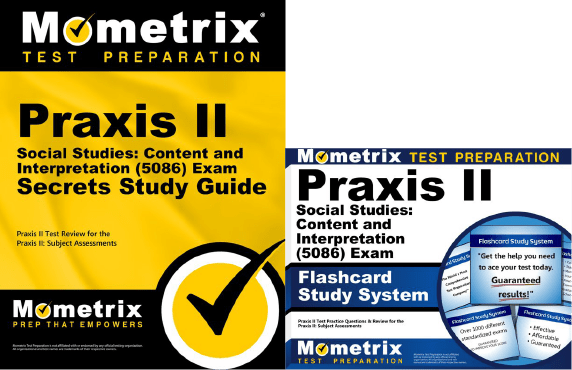If you need help studying for the Praxis Social Studies: Content and Interpretation test or just want some more information about what the test is like, you’ve come to the right place!
Click below to take a free Praxis Social Studies: Content and Interpretation practice test!
What’s on the Exam?
First, let’s talk about the questions on the Praxis Social Studies: Content and Interpretation test. There are 93 questions in total, most being selected-response and some being constructed-response.
90 questions
Selected-response questions require you to select the correct answer from a list of options. Multiple-choice questions are the most common example, but you may also see true-or-false questions and “matching” questions, which ask you to match terms or concepts with their definitions.
Constructed-Response (CR)
3 questions
The constructed-response questions require you to write your answer instead of selecting from a list of choices. Your response to these questions is generally expected to be at least a few sentences, but you’ll be given specific details and instructions before you take the test.
The time limit for the test is 2 hours. There aren’t any scheduled breaks, but you’re free to take restroom breaks as needed!
Let’s take a closer look at the different sections of the test:
1. United States History
18 questions
- The United States Constitution, the Bill of Rights, and their influence on early political development
- The origins and impact of the American Revolution on the founding of the United States
- The causes and effects of the United States’ territorial expansion
- The causes and outcomes of sectionalism, the Civil War, and Reconstruction in the 19th century
- Relationships among industrialization, urbanization, and immigration during the late 19th and early 20th centuries
- Political, economic, social, and cultural developments from the Progressive Era to the New Deal
- The causes and outcomes of US involvement in the First and Second World Wars, both domestically and internationally
- The origins, development, and consequences of the Cold War within the US and globally
- Social, economic, and technological changes in the latter half of the 20th century
- Major economic transformations within the United States
- The ongoing influence of race, gender, and ethnicity in American history
- The emergence of the United States as a global power and its evolving international role
- The struggles and achievements of individuals and groups for expanded political and civil rights throughout US history
2. World History
18 questions
- Formation, organization, and interactions of classical civilizations in Greece, Rome, Persia, India, and China from 1000 BCE to 500 CE
- Transformation of classical civilizations due to invasions, trade, and religious spread from 300 CE to 1400 CE
- Political, social, and economic developments in Europe from the Renaissance through the Enlightenment
- Political, social, economic, and biological impacts of global interactions like trade, exploration, and colonization from 1200 to 1750 CE
- Causes and consequences of revolutions, nationalism, and imperialism from 1750 to 1914 CE
- Ideological, economic, and political causes and outcomes of the World Wars and the Cold War
- Major developments of the post-Cold War world
- Impact of technological innovations and adaptations on world societies
- Influence of major world religions on societies and key historical turning points
- Role of trade and economic exchange both within and between societies
- Influence of political ideologies on modern societal organization
- Economic transformations affecting global societies
- Differences and similarities in family structure and gender roles across societies
3. Government/Civics/Political Science
18 questions
- Major political theorists and their contributions to government systems
- Development of contemporary legal systems and familiarity with modern legal issues
- Key concepts and ideas underlying the United States government
- Operation of the electoral system in the United States
- Mechanisms for individuals to influence government and basic citizenship rights and responsibilities
- Origins, roles, and interactions of the three branches of the federal government
- Origins, evolution, and ongoing impact of the United States Constitution
- Development and politics of civil rights and civil liberties in the United States
- Roles of political parties, interest groups, and the media in elections and policymaking
- Impact of federalism on US politics
- Characteristics of different political systems
- Interaction of national governments, NGOs, and international organizations within the current global system
- Relationships between political systems and economic conditions
4. Economics
13 questions
- Concepts of scarcity, choice, and opportunity costs
- Differences between market, command, and mixed economies
- Principle of supply and demand and market equilibrium
- Impact of government intervention on the economy
- Consumer income allocation to meet needs and wants
- Basic principles of personal finance
- Factors of production
- Behavior of profit-maximizing firms across different market structures
- Variation in personal wealth within different economic systems
- Different measures of economic performance
- Functioning of the banking system and its relationship to economic activity
- Factors influencing economic growth and public policies promoting it
5. Geography
13 questions
- Map types, projections, and organizing information from a spatial perspective
- Use of mental maps for organizing spatial information
- Recognition and interpretation of spatial patterns at local to global scales
- Locating and using sources of geographic data
- Applying spatial concepts to interpret data
- Effects of physical processes, climate patterns, and natural hazards on human societies
- Characteristics and spatial distribution of Earth’s ecosystems
- Interrelationships between humans and their environments
- Renewable and nonrenewable natural resources
- Spatial patterns of cultural and economic activities
- Patterns of migration and settlement
- Development and changing nature of agriculture
- Contemporary patterns and impacts of development, industrialization, and globalization
- Demographic patterns and demographic change
- Basic concepts of political geography, including borders, state formation, and areas of conflict
6. Behavioral Sciences
10 questions
- The influence of society on human behavior
- The influence of culture, cultural change, and human adaptation on human behavior
- The impact of learning, personal identity, and development on individual behavior
7. Short Content Essays
3 questions
How to Register
To register for the test, you’ll need to create an account on the ETS website. Once your account has been created, you can submit your application to take the test.
When you submit your registration, you will need to pay the $156 testing fee.
Praxis Scores
The Praxis Social Studies: Content and Interpretation test is scored using a scaled scoring method. Here’s how it works:
For every question you answer correctly, you get one point added to your raw score. At the end of the test, your final raw score will be converted to a scaled score. This scaled score will range somewhere between 100 and 200.
The passing score is 153 in every state except Kentucky. Kentucky’s passing score is 148.
The reason your raw score is converted to a scaled score is because everyone that takes the test is given a slightly different set of questions. Since everyone has a different arrangement of questions, and because some questions are harder than others, converting your raw score to a scaled score ensures a more even playing field.
FAQs
How many questions are on the Praxis Social Studies: Content and Interpretation exam?
The exam contains 93 questions.
What is the time limit for the Praxis Social Studies: Content and Interpretation exam?
The exam is timed at 2 hours.
What is the passing score for the Praxis Social Studies: Content and Interpretation exam?
You’ll need to get a final scaled score of at least 153 to pass (148 in Kentucky).
How much does the Praxis Social Studies: Content and Interpretation exam cost?
The testing fee is $156.



 Praxis Study Guide
Praxis Study Guide Praxis Flashcards
Praxis Flashcards